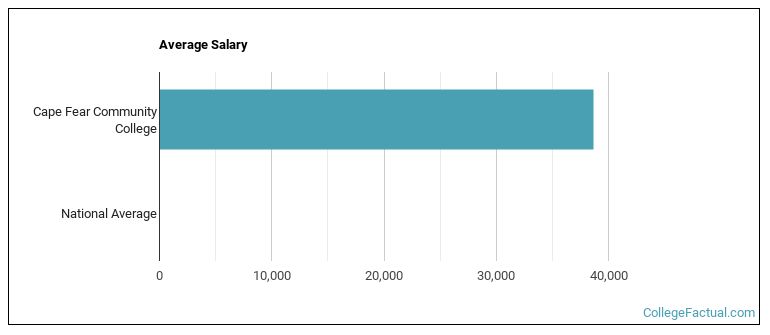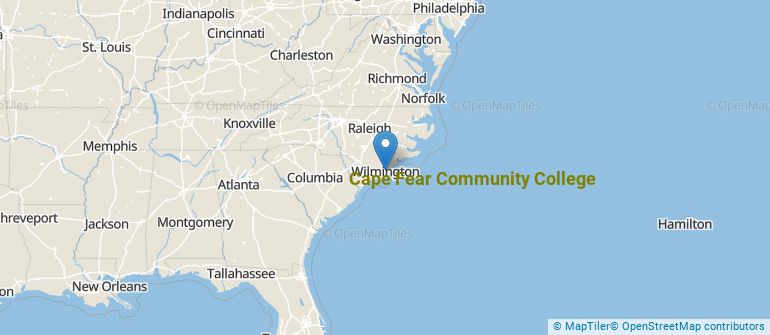 by our College Data Analytics Team
by our College Data Analytics TeamExplore the best ranked schools for the programs you are most interested in.
CFCC landed the #1,800 spot in College Factual's 2025 ranking of best overall colleges in the United States. The higher ed experts analyzed 2,152 colleges and universities across the nation to determine this ranking.
Out of the 93 colleges in North Carolina, CFCC is ranked at #71.
If you are worried about getting into Cape Fear Community College, don't be. The school has a liberal open admissions policy, which means you only need to meet basic requirements in order to be admitted. Still, be sure to submit a complete application and provide any other requested materials.
The student to faculty ratio is often used as a measure to gauge how much access students will have to their professors - the lower the number, the better. At Cape Fear Community College, this rate is 24 to 1, which is high when compared to the national average of 15 to 1.
In addition to the student to faculty ratio, some people look at what percentage of faculty members are full-time as a sign of how much time professors will be able to spend with their students. This is because part-time teachers may not be be on campus as much as their full-time counterparts.
The full-time faculty percentage at Cape Fear Community College is 33%. This is lower than the national average of 47%.
The freshmen retention rate of 10% tells us that most first-year, full-time students don't stick around for a second year at Cape Fear Community College. Students may have a variety of reasons for this, such as only intending to attend a school for one year while they brush up on certain subjects.
During the 2017-2018 academic year, there were 8,680 undergraduates at CFCC with 3,054 being full-time and 5,626 being part-time.
| $0-30 K | $30K-48K | $48-75 | $75-110K | $110K + |
|---|---|---|---|---|
| $6,831 | $7,226 | $8,466 | $12,438 | $13,967 |
The net price is calculated by adding tuition, room, board and other costs and subtracting financial aid.Note that the net price is typically less than the published for a school. For more information on the sticker price of CFCC, see our tuition and fees and room and board pages.
Almost 66% of college students who graduated with the class of 2018 took out student loans, but that percentage varies from school to school. At CFCC, approximately 11% of students took out student loans averaging $9,710 a year. That adds up to $38,840 over four years for those students.
Get more details about paying for Cape Fear Community College.

See which majors at Cape Fear Community College make the most money.
Get more details about the location of Cape Fear Community College.

Contact details for CFCC are given below.
| Contact Details | |
|---|---|
| Address: | 411 North Front Street, Wilmington, NC 28401-3910 |
| Phone: | 910-362-7000 |
| Website: | www.cfcc.edu/ |
| Most Popular Majors | Bachelor’s Degrees | Average Salary of Graduates |
|---|---|---|
| Liberal Arts General Studies | 906 | NA |
| Cosmetology | 108 | NA |
| Nursing | 75 | NA |
| Criminal Justice & Corrections | 75 | NA |
| Building Management & Inspection | 68 | NA |
| Vehicle Maintenance & Repair | 65 | NA |
| Clinical/Medical Laboratory Science | 64 | NA |
| Heating, Air Conditioning, Ventilation & Refrigeration | 61 | NA |
| Precision Metal Working | 60 | NA |
| Accounting | 57 | NA |
Online learning options are becoming more and more popular at American colleges and universities. Online classes are great for students who have busy schedules or for those who just want to study on their own time.
In 2022-2023, 7,549 students took at least one online class at Cape Fear Community College. This is a decrease from the 10,250 students who took online classes the previous year.
| Year | Took at Least One Online Class | Took All Classes Online |
|---|---|---|
| 2022-2023 | 7,549 | 4,133 |
| 2021-2022 | 10,250 | 4,632 |
| 2020-2021 | 8,640 | 8,583 |
| 2018-2019 | 3,794 | 1,177 |
Learn more about online learning at Cape Fear Community College.
Footnotes
*The racial-ethnic minorities count is calculated by taking the total number of students and subtracting white students, international students, and students whose race/ethnicity was unknown. This number is then divided by the total number of students at the school to obtain the racial-ethnic minorities percentage.
References
More about our data sources and methodologies.